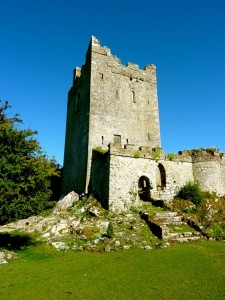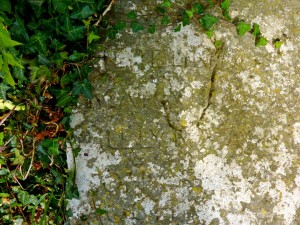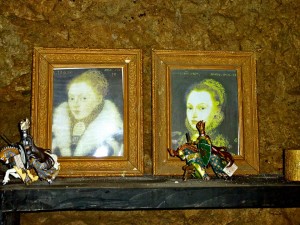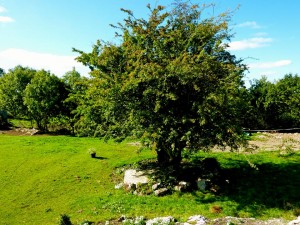
To celebrate St Patrick’s Day I tend to write about Anne Boleyn’s links to Ireland, but today I’m going to focus on the legend that links George Boleyn to Clonony Castle in County Offaly, Ireland, a castle that was built by the MacCoghlan clan in the early 1500s.
The following article is based on part of the appendix of George Boleyn: Poet, Courtier and Diplomat, the book that Clare Cherry and I will be releasing at the end of next month…
At the 1868 annual general meeting of the Historical and Archaeological Society of Ireland, in Kilkenny, a rubbing from the inscription on a tomb slab from Clonony Castle was examined. This slab was known locally as the monument of “Queen Elizabeth’s cousins” and read:
“HERE UNDER LEYS ELIZABETH AND MARY BULLYN DAUGHTERS OF THOMAS BULLYN SON OF GEORGE BULLYN THE SON OF GEORGE BULLYN VISCOUNT ROCHFORD SON OF SIR THOMAS BULLYN EARLE OF ORMONDE AND WILTSHIRE”

The slab was recorded as measuring seven feet by four feet, and being sixteen inches in thickness, and it was stated that it had been removed from a nearby quarry to the castle in the first quarter of the 19th century.1 Reference was then given to an article in “The Irish Penny Magazine” (September 1833) which told the story of the discovery of the tomb slab.2 According to the magazine article, labourers busy gathering stone for building work near Clonony Castle, in 1803, found a cave about a hundred yards from the castle. In the cave in the limestone rock, “about twelve feet under the surface” and beneath a pile of stones, they found a “large limestone flag” and “a coffin cut in the rock”, which contained the remains of two bodies. From the inscription on the limestone flag, these remains were identified as second cousins of Queen Elizabeth I, being great-granddaughters of George Boleyn, Lord Rochford.
The writer of the magazine article went on to ponder how these Boleyn girls ended up “interred in this obscure corner of the King’s county”, wondering if their father was employed in Ireland during the troubles in Elizabeth I’s reign or whether members of the Boleyn family fled from England to Ireland “to escape the fury of King Henry VIII” when Anne Boleyn and her brother fell in 1536. When the writer of the article shared the discovery of the tombstone with the Earl of Ross, who was descended through his mother from Alice, daughter of Sir William Boleyn of Blickling, the Earl showed him portraits of two young women at Birr Castle. Nobody knew who they were, but the paintings were marked “Anno aetatis 18” and “Anno aetatis 19” and “Anno Domini 1567″, meaning that the girls were in their 18th and 19th years when they were painted in 1567, and the Earl suggested that these were portraits of Elizabeth and Mary Boleyn. The portrait of the girl thought to be Mary pictured her with a marigold, for “Mary”, stuck behind an ear and the other girl was pictured wearing a jewel in the form of an “E” for Elizabeth. Both the Earl and the writer of the article became convinced that these girls were the Boleyn girls of the tomb. Birthdates of 1548 and 1547, however, make no sense if these girls are meant to be granddaughters of George Boleyn. Lady Rosse, the present owner of Birr Castle, believes the girls depicted in the portrait to be Margaret and Elizabeth Clere, daughters of John Clere of Ormesby St Margaret, Norfolk, who was the son of Robert Clere and Alice Boleyn, Anne Boleyn’s paternal aunt.3 The present Earl of Rosse descends from the Cleres through his great-great-great-great-grandmother, Mary Clere. When I researched the Cleres, I found that Margaret Clere married Walter Haddon (1514/1515-1571) and gave him four children. Haddon remarried in December 1567 so Margaret must have been dead by this time and it appears unlikely that she would have been 18 at her death in 1567, the year she was said to have been painted. However, there appears to be a Boleyn link as the paintings came into the Parsons family (the Earl of Rosse’s family) at the same time as a head and shoulder portrait of Anne Boleyn.
Lady Rosse believes, and I agree with her, that the girls from the portraits are not the girls of the Clonony tomb. Both pairs of girls are linked to the Boleyns, with regards to the Clere family and the tombstone inscription, but they cannot be the same sisters.

In Burke’s peerage, there is a mention of an “Anne Boleyn”, wife of Sir Robert Newcomen, baronet, and a “great-niece of Queen Elizabeth”, in the 17th century in Ireland. This suggests that she too descended from George Boleyn and may have been the sister of the Elizabeth and Mary of the tomb.4
The story told locally is that Clonony Castle was given to Thomas Boleyn, Earl of Ormond and Wiltshire, father of Anne Boleyn, by Henry VIII after it was ceded to the King by John Óg MacCoghlan. When George and Anne Boleyn were executed in 1536, George’s illegitimate son was moved to Clonony to keep him safe. Mary and Elizabeth Boleyn were descended from this man. When Elizabeth died young, Mary was devastated and committed suicide, throwing herself from Clonony Castle tower. The sisters were buried behind the castle and their grave eventually became forgotten until it was found by labourers digging stone for the canal which they were building by the castle. The girls’ remains were reinterred in a local graveyard and the tombstone moved to the castle, where it still lies beneath a hawthorn tree. It is difficult to decipher the inscription today, due to weather damage, but rubbings have been made.5

There is no evidence at all that the Boleyn girls of Clonony were descended from George Boleyn, Lord Rochford. There is no mention of Jane having a child when she was executed in 1542, and no mention in any records of George having an illegitimate son. It is not impossible, however, for him to have had an illegitimate son who grew up in Ireland away from the English court. It would be nice to think that George left something behind.
By the way, I’m still digging into this so there may well be more in the appendix when the book is published.
Happy St Patrick’s Day!
For more about Anne Boleyn’s links to Ireland, see Anne Boleyn’s Irish Roots – Lady Margaret Butler and the Butlers of Kilkenny Castle.
Notes and Sources
- The Journal of The Historical and Archaeological Association of Ireland, Originally Founded as the Kilkenny Archaeological Society, I Part I:85–86.
- “Tomb of the Bullens – Cousins-German of Queen Elizabeth.” Irish Penny Magazine, September 21, 1833.
- Correspondence with Lady Rosse and Paudie Kennelly.
- Burke, John. A General and Heraldic Dictionary of the Peerage and Baronetage of the British Empire, 2:484.
- Told to me by Paudie Kennelly after he had visited Clonony Castle and spoken to Rebecca Black, the owner.
Thank you for the article Claire, a story full of intrigue indeed.While the evidence is not yet convincing butI still believe the girls of Clonony to be Boleyns and some day the link I hope will be established. Birr Castle is one of the most popular castles to visit in Ireland with its extensive gardens and Clonony Castle, just a few miles away also well deserving a visit. Clonony is being painstakingly restored by Rebecca Black and she has such a connection with the castle and its history. There is a thread on my visit to Clonony in the forum here. I would also like to thank Lady Rosse for her help and information who has a great personal interest in this story and had done much research over the years herself on the Portraits above (Copies of the originals at Birr, in the Birr Castle collection) and the mystery of the girls Boleyn of Clonony. A happy Saint Patrick’s day to everyone on the Anne Boleyn Files from the Green Isle!
Yes, Lady Rosse has been wonderful and she is certainly going to get a big thank you in our book. Her passion for the subject shines through her in her emails too and I really hope that one day she gets a definitive answer to who these girls in her portraits were.
Happy St Patrick’s Day!
I am looking forward to the book, Claire. Happy St. Patrick’s Day from Ireland!
Happy St Patrick’s Day Mary!
Very interesting Claire. You never cease to amaze me with what you find. I have never been to Ireland…….but when I go I will visit this place for sure!
I thought illegitimate children in the past always were known by the mothers surname ,so how could George Boleyn have had a son with the Boleyn or bullen name unless he recognised this child as his ,and if so there would have surely been some documents about said child,and in saying that there could be possibly a lot more boleyns out there .
I read somewhere that Elizabeth I gave a place to a clergyman named “George Boleyn”, who may have been the son (even if illegitimate) of Anne’s brother — although there is no evidence on this point. Are the Boleyn family records sufficiently complete that we can say that, if George did have a son, there would be a record of it? Also, could these girls be related to this clergyman? Happy St. Patrick’s Day from here in Southern California.
Interesting article – and what a way to have allowed the family line to survive if true.
George Boleyn was a handsome, popular courtier, who is to say that perhaps amongst any premarital or extramarital dalliances he could NOT have had any children? It would make sense, due to the strong connection the Boleyn family had to Ireland, that any of those children could have ended up there.
Thomas (Anne and George’s father) might have wanted to hide any hint of scandal during his rise in court. Contradicting the “bad father” legend that has grown up around Thomas, he might have farmed out any “indiscretions” among the family in Ireland, which were far from court, to make something of themselves, but still have family close at hand for guidance.
George himself, for that matter, might have wanted any child of his, legitimate or not, to have space to grow up and make something of him or herself, without the taint of scandal that illegitimacy that would have limited their options in England.
Anything is possible, but I would prefer to think the better of the Boleyns, especially since there is so little reliable record of the characters of either Thomas or George, both of whom have been smeared (rightly or wrongly) since Tudor times.
Happy St Patrick’s Day, have a guiness to celebrate! What an interesting article. I was wondering how George Boleyn had children or grandchildren till I got near the end and you mentioned his illegitimate son. Who was the son’s mother? I had no idea he even had an illigitimate son, this was very interesting information, thank you. But then the girls turn out not to be his descendents, oh well, the mystery deepens. But the Boleyns did have relations in Ireland as the Butlers were their cousins and they made a claim on the Earldom of Ormonde because of that connection. Thomas Boleyn missed out on the claim at first but later was granted it when he was given his own Earldoms of Wiltshire and Ormonde by Henry VIII. It is interesting that the slab and stone are found near a cave and that there is something of a mystery about the entire thing. But we Irish love a good tale. Happy Paddy Day again.
The thing that gets me is ,It is stated on their tombstone that they are related to George Boleyn and his father Thomas ,I think that is evidence enough.
It would indeed be interesting if someone could find out exactly where the two sisters are buried now.Maybe someday DNA tests could be carried out on them with any Boleyn relatives ;if the family still is around.It might even be that maybe whoever thought the girls were grandchildren of George might have been mistaken. Maybe they are grandchildren of another Boleyn. Not sure how many brothers Thomas had.It’s just a wild theory of mine
How interesting and intriguing.
I wonder why all that trouble was gone to inscribe the tomb to such a length if there wasn’t any truth to it?….wouldn’t it be great if it could be proved that George had fathered a son….keep digging Claire!!
It seems that I remember that George made some remarks at his execution that some have construed to support their theory that he was homosexual. However, if he was referring to activity that led to an illegitimate son then perhaps his comments are more understandable.
I have long heard the story that the Bulfin family of Derrinlough House, Five Alley, Birr, were related to the Boleyn. Their name was originally believed to be Bullen, a common variation of Boleyn. has anyone else heard this story?
maybe they were relatives of the Earl of Ross or as you say George Boleyn could have had a mistress in Ireland but George Boleyn of Litchfield wasn’t his son when he died he left his money to servants
I am no expert but if the story of finding the bodies was true maybe they got the inscription wrong because there was very little of it left and also i dont think any illegitimate boleyns wouldnt have been in any danger from King Henry
I am no expert but if the story of finding the bodies was true maybe they got the inscription wrong because of the passage of time there was very little of it left and the finders made a few assumptions
I’m a descendant of Anne Boleyn m. Newcomen. I’m guessing there are a lot of us still in Ireland. I’ve read a lot about her being described a relative of Queen Elizabeth and some times great niece of Elizabeth so this is all fascinating. I hope one day it can be solved.